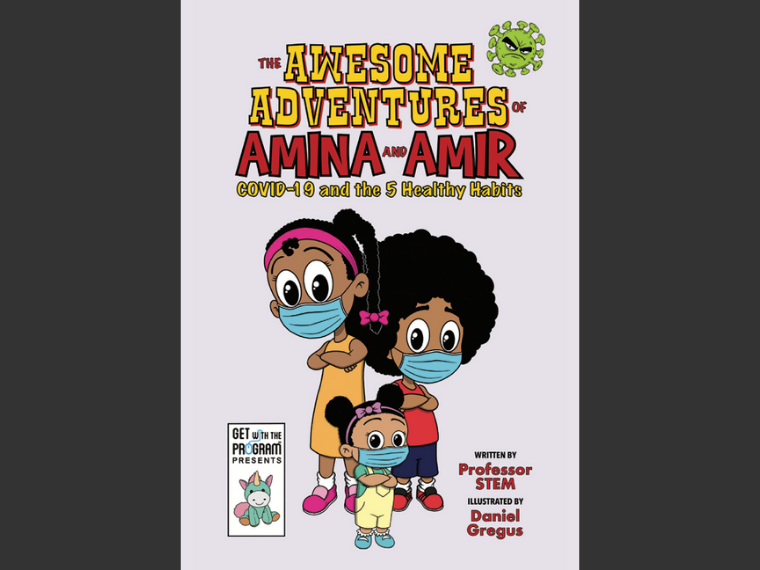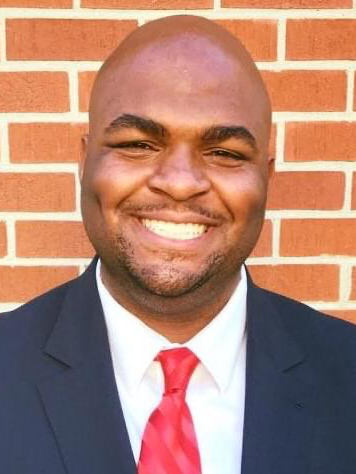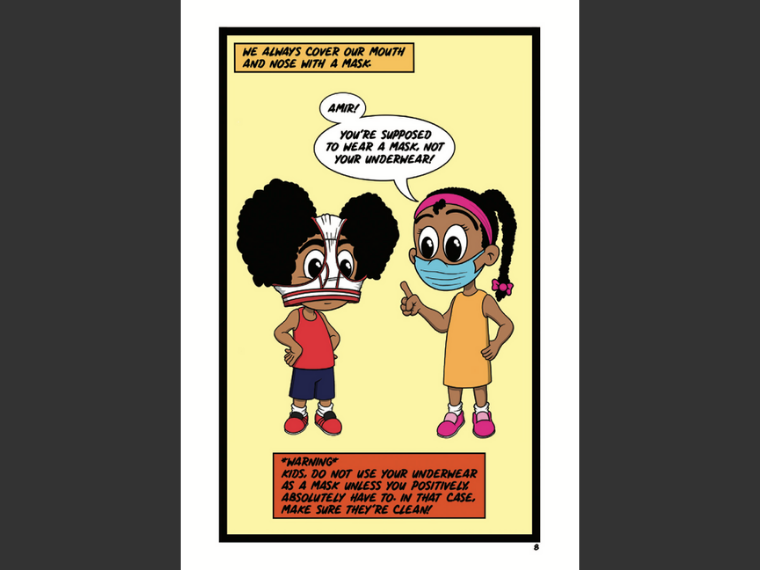A Conversation with Jason Williams ’05, ‘Professor STEM’
August 5, 2020
Amanda Nagy

The Awesome Adventures of Amina and Amir: COVID-19 and the 5 Healthy Habits was published in July.
Photo credit: Jason Williams
Jason Williams ’05 is president of the Oberlin Schools Board of Education. In 2015, he founded Get With the Program, Inc., a nonprofit organization that promotes and reinforces literacy in science, technology, engineering, and mathematics (STEM) among preschool through 12th grade, through Oberlin’s LaunchU Business Accelerator.
He recently published a book for parents and youth, The Awesome Adventures of Amina and Amir: COVID-19 and the 5 Healthy Habits. In this Q&A, Williams discusses his inspiration for the book and offers some advice for parents and kids to stay safe and socially connected in the new reality of the COVID-19 pandemic.
Tell us a little about the impetus for this book. Since you’re a STEM advocate, were you having lots of conversations about the COVID-19 virus in your home?
The impetus for this book grew from conversations with my children, who are the story’s protagonists, as well as my passion to engage children around STEM education. My children inspire a lot of what I do in life. They were the inspiration in me founding Get with the Program, Inc., a STEM-based nonprofit organization that promotes literacy in science, technology, engineering, and mathematics (STEM) among preschool through 12th-grade scientists; and they were the inspiration behind me writing and publishing my first children’s book, The Awesome Adventures of Amina and Amir: COVID-19 and the 5 Healthy Habits.

Photo credit: Courtesy of Jason Williams
I am always looking for creative ways to engage children around STEM. Unfortunately, with the school closures due to COVID-19, all of our after-school and out-of-school programs throughout Northeast Ohio came to an abrupt end. During the stay-at-home order, I wanted to find a way to continue engaging children around STEM education. While discussing COVID-19, school and business closures, and why my kids could no longer play with their friends, I had the idea of presenting this information through a children’s book. I realized that all children were experiencing this and I wanted to provide accurate information, as well as practical steps children can follow to help protect themselves.
You use your own children, Jaylynn Amina, Amir, and Anissa, ages 12, 11, and 5 respectively, as characters to tell a story about the COVID-19 virus. How did they cope with the uncertainties and abrupt changes when K-12 schools closed in March?
It was and continues to be difficult. They want to play with their friends, participate in summer camps, and do everything else that they are accustomed to doing; however, they can’t. Personally, we have had a lot of family time. We have watched a lot of popular '90s TV shows from my childhood (they especially enjoy Martin, Hanging with Mr. Cooper, and Family Matters), they learned how to play Spades (a popular card game), and have done various art projects. My wife, Arisa Williams ’06, has also been teaching them how to read and write in Japanese.
This is a lot for adults to process, let alone children. Our household has a particular focus on art at the moment, as that provides an outlet for the kids. Oftentimes, children feel emotions that they cannot express verbally, but may be able to through art. Additionally, we created a website with free resources including links to stress management and mental health toolkits at www.AminaAndAmir.com.
Walk us through the topics covered in the book and why they’re important. What do you want parents and kids to take away from the lessons?
There are a few things. There’s a parent guideline provided at the beginning of the book, which presents parents with sample questions on how to talk to their child about COVID-19 as well as comprehension questions about the story and the 5 Healthy Habits. This is important because children may be scared for themselves, their family, and their friends. Parents/guardians, teachers, and other adults can play a pivotal role in helping children understand what’s happening and make sense of any anxiety or fear. Additionally, it’s always a plus to work on reading comprehension skills.

The next topic would be the 5 Healthy Habits (5HH). The 5HH was inspired by the CDC’s protective measures recommendations. Social distancing, wearing a mask, washing your hands, covering your mouth and nose when you cough and sneeze, and disinfecting touched surfaces frequently, are all imperative to limiting the spread of the coronavirus (and germs and viruses in general). These are actionable steps that children (and adults) can take to help protect themselves.
The last topic would be the overall theme of the book: the smallest kids can have the biggest impact. Amina, Amir, and Anissa struggle with this new way of living as a result of a pandemic. However, they learn about COVID-19 and ways to help limit its spread. This is something that all kids can do. This is important because it empowers children. Regardless of how big a problem presents itself, through actionable steps, it can be solved (or alleviated in the case of COVID-19).
Overall, I want parents and kids to adopt the 5 Healthy Habits and use this time to connect with one another. This book is a centerpiece to those connections.
Families and K-12 school districts are grappling with the hard decisions about how to return to the classroom in the fall. Do you think this book could be an important resource for keeping school environments safe?
Definitely! This book emphasizes the importance of wearing a mask, social distancing, washing your hands, disinfecting frequently, and covering your mouth and nose when you sneeze or cough (the 5 Healthy Habits), which is a part of this new reality. In working with children, it’s best to present new information in fun and engaging ways. While they’re having fun, sneak some learning in there. This book presents a scary topic in a fun way while providing actionable steps to help limit the spread of not only the coronavirus but all germs and viruses.
Children are hearing a lot of buzzwords surrounding the pandemic, and the biggest theme seems to be “uncertainty”— there’s the uncertainty about contracting or carrying the virus, and young kids are carrying the heavy burden of social distancing. Do you have any advice for helping kids deal with the social and emotional impact of the pandemic?
My advice would be to reinforce and practice the 5 Healthy Habits, stay active (outdoor play time and indoor activity breaks), stay socially connected with friends and family (technology allows us to do this while social distancing), encourage various forms of artistic expression (to help children cope), and to check out www.AminaAndAmir.com.
We curated links from the Center for Disease Control and Prevention, the Child Mind Institute, and other links to mental health resources for parents and children. Additionally, we have activities such as coloring pages, facemask DIY, links to World Health Organization indoor activities, and much more.
You may also like…
Learning by Teaching: Oberlin Students Share Global Music with Young Learners
College and Conservatory students in PACE 103 prepare local children for an immersive community concert at Oberlin.
Nuiko Wadden ’02 Joins Oberlin Conservatory Faculty as Assistant Professor of Harp
The versatile musician brings extensive opera, orchestral, and contemporary music experience to her role
Leo Hidy ’23 Earns 2026 Marshall Scholarship
Leo Hidy ’23, a comparative American studies major who also studied business and economics while at Oberlin, has received a 2026 Marshall Scholarship that will fund two years of graduate study in the UK.


